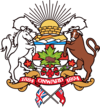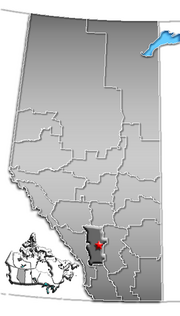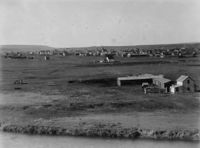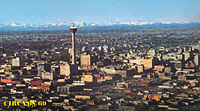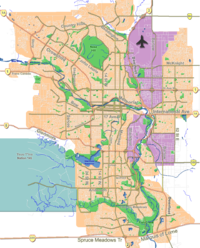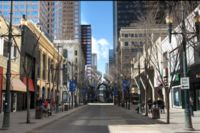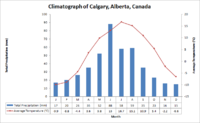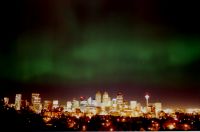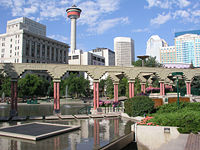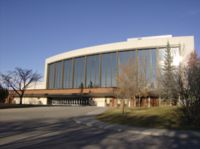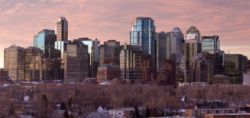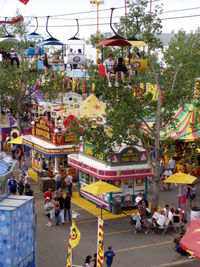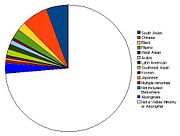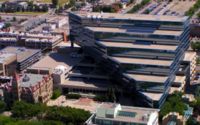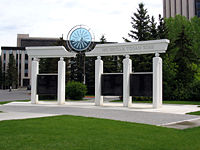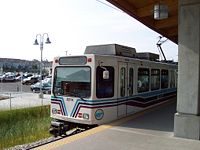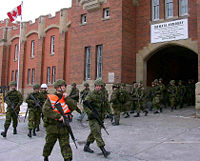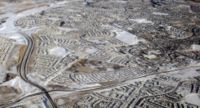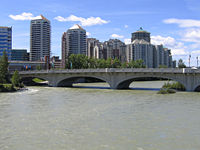Calgary
2008/9 Schools Wikipedia Selection. Related subjects: Cities; North America
| City of Calgary | |||
| Downtown Calgary | |||
|
|||
| Nickname(s): Cowtown, The Stampede City , The Heart of the New West, The Sandstone City | |||
| Motto: Onward | |||
| Location of Calgary in Alberta | |||
| Coordinates: | |||
|---|---|---|---|
| Country | |||
| Province | |||
| Region | Calgary Region | ||
| Census division | 6 | ||
| Established | 1875 | ||
| Incorporated | 1884 (town) | ||
| 1894 (city) | |||
| Government | |||
| - Mayor | Dave Bronconnier ( Past mayors) |
||
| - Governing body | Calgary City Council | ||
| - Manager | Owen A. Tobert | ||
| - MPs |
List of MPs
|
||
| - MLAs |
List of MLAs
|
||
| Area | |||
| - City | 726.50 km² (280.5 sq mi) | ||
| - Metro | 5,107.43 km² (1,972 sq mi) | ||
| Elevation | 1,048 m (3,438 ft) | ||
| Population (2007) | |||
| - City | 1,042,892 | ||
| - Density | 1,360.2/km² (3,522.9/sq mi) | ||
| - Metro | 1,162,100 | ||
| - Metro Density | 211.3/km² (547.3/sq mi) | ||
| - Population rank | 3rd | ||
| - Metro rank | 5th | ||
| Time zone | MST ( UTC−7) | ||
| - Summer ( DST) | MDT ( UTC−6) | ||
| Postal code span | T1Y to T3R | ||
| Area code(s) | 403 | ||
| Website: City of Calgary | |||
Calgary (IPA: /ˈkælgəriː/) is the largest city in the province of Alberta, Canada. It is located in the south of the province, in an area of foothills and high plains, approximately 80 kilometres (50 mi) east of the front ranges of the Canadian Rockies. The city is located in the Parkland region of Alberta. Calgary is the third largest civic municipality, by population, in Canada. As of the 2008 civic census, Calgary's population was 1,042,892. The metropolitan population ( CMA) was 1,079,310 in 2006, making Greater Calgary the fifth largest census metropolitan area in the country. Because it is located 298 kilometres (178.8 mi) due south of Edmonton, statisticians define the narrow populated area between these cities as the " Calgary-Edmonton Corridor". Calgary is the largest Canadian metropolitan area between Toronto and Vancouver. A resident of Calgary is known as a Calgarian.
Calgary is well-known as a destination for winter sports and ecotourism with a number of major mountain resorts near the city and metropolitan area. Economic activity in Calgary is mostly centred on the petroleum industry; however, agriculture, tourism, and high-tech industries also contribute to the city's fast economic growth. Calgary holds many major annual festivals which include the Calgary Stampede, the Folk Music Festival, the Lilac Festival, One Yellow Rabbit High Performance Rodeo — Calgary's International Festival of the Arts, Wordfest: Banff-Calgary International Writers Festival, One World Festival ( GlobalFest), and the fourth largest Caribbean festival in the country (Carifest). In 1988, Calgary became the first Canadian city to host the Olympic Winter Games, and one of the fastest long track speed skating ice rinks in the world was built at the University of Calgary to accommodate these Games.
Calgary was ranked the world's cleanest city by Mercer Quality of Living in a survey published in 2007 by Forbes magazine
History
First settlement
Before the Calgary area was settled by Europeans, it was inhabited by Pre- Clovis people whose presence has been traced back at least 11,000 years. In 1787 cartographer David Thompson spent the winter with a band of Peigan encamped along the Bow River. He was the first recorded European to visit the area, and John Glenn was the first documented European settler in the Calgary area, in 1873.
The site became a post of the North-West Mounted Police (now the RCMP). Originally named Fort Brisebois, after NWMP officer Éphrem-A. Brisebois, it was renamed Fort Calgary in 1876 by Colonel James Farquharson Macleod. The NWMP detachment was assigned to protect the western plains from U.S. whiskey traders. Fort Calgary was named by Colonel Macleod after Calgary on the Isle of Mull, Scotland. While there is some disagreement on the naming of the town, the Museum on the Isle of Mull explains that kald and gart are similar Norwegian words, meaning cold and garden, that were likely used when named by the Vikings who inhabited the Inner and Outer Hebrides.
When the Canadian Pacific Railway reached the area in 1883 and a rail station was constructed, Calgary began to grow into an important commercial and agricultural centre. The Canadian Pacific Railway headquarters are located in Calgary today. Calgary was officially incorporated as a town in 1884 and elected its first mayor, George Murdoch. In 1894, it was incorporated as "The City of Calgary" in what was then the North-West Territories.
The oil boom
Oil was first discovered in Alberta in 1902, but it did not become a significant industry in the province until 1947 when huge reserves of it were discovered. Calgary quickly found itself at the centre of the ensuing oil boom. The city's economy grew when oil prices increased with the Arab Oil Embargo of 1973. The population increased by 272,000 in the eighteen years between 1971 (403,000) and 1989 (675,000) and another 345,000 in the next eighteen years (to 1,020,000 in 2007). During these boom years, skyscrapers were constructed at a pace seen by few cities anywhere. The relatively low-rise downtown quickly became dense with tall buildings, a trend that continues to this day.
Calgary's economy was so closely tied to the oil industry that the city's boom peaked with the average annual price of oil in 1981. The subsequent drop in oil prices and the introduction of the National Energy Program were cited by industry as reasons for a collapse in the oil industry and consequently the overall Calgary economy. The NEP was cancelled in the mid-1980s by the Brian Mulroney federal government. However, low oil prices prevented a full recovery until the 1990s.
Recent history
With the energy sector employing a huge number of Calgarians, the fallout from the economic slump of the early 1980s was understandably significant. The unemployment rate soared. By the end of the decade, however, the economy was in recovery. Calgary quickly realized that it could not afford to put so much emphasis on oil and gas, and the city has since become much more diverse, both economically and culturally. The period during this recession marked Calgary's transition from a mid-sized and relatively nondescript prairie city into a major cosmopolitan and diverse centre. This transition culminated in February 1988, when the city hosted the XV Olympic Winter Games. The success of these games essentially put the city on the world stage.
Nonetheless, some visitors have commented on the city's marked lack of lively streets and nightlife, as well as the staid nature of its inhabitants, despite their notable standing on the world stage.
Thanks in part to escalating oil prices, the economy in Calgary and Alberta is now booming, and the region of nearly 1.1 million people is the fastest growing in the country. While the oil and gas industry comprise an important part of the economy, the city has invested a great deal into other areas such as tourism and high-tech manufacturing. Over 3.1 million people now visit the city annually for its many festivals and attractions, especially the Calgary Stampede. The nearby mountain resort towns of Banff, Lake Louise, and Canmore are also becoming increasingly popular with tourists, and are bringing people into Calgary as a result. Other modern industries include light manufacturing, high-tech, film, transportation, and services. The city has ranked highly in quality of life surveys: 25th in the 2006, 24th in 2007 and 25th again in the 2008 Mercer Quality of Living Survey, and 10th best city to live in according to the Economist Intelligence Unit (EIU). Despite the oil industry's dominance in Alberta's economy, Calgary ranked as the world's cleanest city by Forbes Magazine in 2007.
Geography
Calgary is located at the transition zone between the Canadian Rockies foothills and the Canadian Prairies, and is relatively hilly as a result. Calgary's elevation is approximately 1,048 metres (3,440 ft) above sea level downtown, and 1,083 metres (3,553 ft) at the airport. The city proper covers a land area of 726.5 km² (280.5 sq mi) (as of 2006) and as such exceeds the land area of the City of Toronto.
There are two major rivers that run through the city. The Bow River is the largest and flows from the west to the south. The Elbow River flows northwards from the south until it converges with the Bow River near downtown. Since the climate of the region is generally dry, dense vegetation occurs naturally only in the river valleys, on some north-facing slopes, and within Fish Creek Provincial Park.
The city is large in physical area, consisting of an inner city surrounded by various communities of decreasing density. Unlike most cities with a sizable metropolitan area, most of Calgary's suburbs are incorporated into the city proper, with the notable exceptions of the city of Airdrie to the north, Cochrane to the northwest, Strathmore to the east, and the sprawling Springbank district to the west. Though it is not technically within Calgary's metropolitan area, the town of Okotoks is only a short distance to the south and is considered a suburb as well. The Calgary Economic Region includes slightly more area than the CMA and has a population of 1,146,900.
The city of Calgary proper is immediately surrounded by two municipal districts, Rocky View No. 44 to the north, west and east; and Foothills No. 31 to the south.
Calgary's neighbourhoods
The downtown region of the city consists of five neighbourhoods: Eau Claire (including the Festival District), the Downtown West End, the Downtown Commercial Core, Chinatown, and the Downtown East Village (also part of the Rivers District). The commercial core is itself divided into a number of districts including the Stephen Avenue Retail Core, the Entertainment District, the Arts District and the Government District. Distinct from downtown and south of 9th Avenue is Calgary's densest neighbourhood, the Beltline. The area includes a number of communities such as Connaught, Victoria Crossing and a portion of the Rivers District. The Beltline is the focus of major planning and rejuvenation initiatives on the part of the municipal government to increase the density and liveliness of Calgary's centre.
Adjacent to, or directly radiating from the downtown are the first of the inner-city communities. These include Crescent Heights, Hounsfield Heights/Briar Hill, Hillhurst / Sunnyside (including Kensington BRZ), Bridgeland, Renfrew, Mount Royal, Mission, Ramsay and Inglewood and Albert Park/Radisson Heights directly to the east. The inner city is, in turn, surrounded by relatively dense and established neighbourhoods such as Rosedale and Mount Pleasant to the north; Bowness, Parkdale and Glendale to the west; Park Hill, South Calgary (including Marda Loop), Bankview, Altadore and Killarney to the south; and Forest Lawn/ International Avenue to the east. Lying beyond these, and usually separated from one another by highways, are the suburban communities, often characterized as "commuter communities". The greatest amount of suburban expansion is happening in the city's deep south with major growth on the northwestern edge as well. In all, there are over 180 distinct neighbourhoods within the city limits.
Several of Calgary's neighbourhoods were initially separate towns that were annexed by the city as it grew. These include Bowness, Montgomery, Forest Lawn, Midnapore, Rosedale and, most recently in 2007, Shepard.
Climate
Calgary has a semi-arid, highland continental climate with long, dry, but highly variable, winters and short, moderately warm summers ( Koppen climate classification BSk, USDA Plant Hardiness Zone 3b). The climate is greatly influenced by the city's elevation and close proximity to the Rocky Mountains. Calgary's winters can be uncomfortably cold; but warm, dry Chinook winds routinely blow into the city from the Pacific Ocean during the winter months, giving Calgarians a break from the cold. These winds have been known to raise the winter temperature by up to 15 °C (27 °F) in just a few hours, and may last several days. The chinooks are such a common feature of Calgary's winters that only one month (January 1950) has failed to witness a thaw over more than 100 years of weather observations. More than one half of all winter days see the daily maximum rise above 0 ℃ (32 ℉). Some winter days even approach 20 ℃ (68 ℉) on occasion.
Calgary is a city of extremes, and temperatures have ranged anywhere from a record low of −45 ℃ (−49 ℉) in 1893 to a record high of 36 ℃ (96.8 ℉) in 1919. Temperatures fall below −30 ℃ (−22 ℉) on about five days per year, though extreme cold spells usually do not last very long. According to Environment Canada, the average temperature in Calgary ranges from a January daily average of −9 ℃ (15.8 ℉) to a July daily average of 16 ℃ (60.8 ℉).
As a consequence of Calgary's high elevation and relative dryness, summer evenings can be very cool, the average summer minimum temperature drops to 8 ℃ (46.4 ℉), and frosts can occur in any month of the year. Calgary has experienced snowfall even in July and August. Calgary experiences summer daytime temperatures exceeding 30 ℃ (86 ℉) on an average of four days per year. With an average relative humidity of 55% in the winter and 45% in the summer, Calgary has a semi-arid climate typical of other cities in the Western Great Plains and Canadian Prairies. Unlike cities further east, like Toronto, Montreal, Ottawa or Winnipeg, humidity is almost never a factor during the Calgary summer.
The city is among the sunniest in Canada, with 2,405 hours of annual sunshine, on average. Calgary International Airport in the northeastern section of the city receives an average of 413 mm (16.3 in) of precipitation annually, with 301 mm (11.9 in) of that occurring in the form of rain, and the remaining 112 mm (4.4 in) as snow. Most of the precipitation occurs from May to August, with June averaging the most monthly rainfall. In June 2005, Calgary received 248 mm (9.8 in) of precipitation, making it the wettest month in the city's recorded history. Droughts are not uncommon and may occur at any time of the year, lasting sometimes for months or even several years. Precipitation decreases somewhat from west to east; consequently, groves of trees on the western outskirts largely give way to treeless grassland around the eastern city limit.
Calgary averages more than 20 days a year with thunderstorms, with almost all of them occurring in the summer months. Calgary lies on the edge of Alberta's hailstorm alley and is prone to occasional damaging hailstorms. A hailstorm that struck Calgary on September 7, 1991, was one of the most destructive natural disasters in Canadian history, with over $400 million dollars in damage. Being west of the dry line on most occasions, tornadoes are rare in the region.
- General seasons (not well-defined in Calgary due to highly variable climate)
- Winter: November to mid-March
- Spring: mid-March to May
- Summer: June to August
- Autumn: September to November
| Weather averages for Calgary | |||||||||||||
|---|---|---|---|---|---|---|---|---|---|---|---|---|---|
| Month | Jan | Feb | Mar | Apr | May | Jun | Jul | Aug | Sep | Oct | Nov | Dec | Year |
| Average high °C | -2.8 | -0.1 | 4.0 | 11.3 | 16.4 | 20.2 | 22.9 | 22.5 | 17.6 | 12.1 | -2.8 | -1.3 | 10.5 |
| Average low °C | -15.1 | -12.0 | -7.8 | -2.1 | 3.1 | 7.3 | 9.4 | 8.6 | 4.0 | -1.4 | -8.9 | -13.4 | -2.4 |
| Precipitation cm | 1.16 | 0.88 | 1.74 | 2.39 | 6.03 | 7.98 | 6.79 | 5.88 | 4.57 | 1.39 | 1.23 | 1.22 | 41.26 |
| Average high °F | 27.0 | 31.8 | 39.2 | 52.3 | 61.5 | 68.4 | 73.2 | 72.5 | 63.7 | 53.8 | 37.0 | 29.7 | 50.9 |
| Average low °F | 4.8 | 10.4 | 18.0 | 28.2 | 37.6 | 45.1 | 48.9 | 47.5 | 39.2 | 29.5 | 16.0 | 7.7 | 27.7 |
| Precipitation inches | 0.45 | 0.35 | 0.68 | 0.94 | 2.37 | 3.14 | 2.67 | 2.31 | 1.79 | 0.54 | 0.48 | 0.48 | 16.24 |
| Source: Environment Canada Dec 2006 | |||||||||||||
Culture
Calgary's urban scene has changed considerably since the beginning of the city's rapid growth. It is also starting to become recognized as one of Canada's most diverse cities. Today, Calgary is a modern cosmopolitan city that still retains much of its traditional culture of hotel saloons, western bars, night clubs, football and hockey. Following its revival in the 1990s, Calgary has also become a centre for country music in Canada. As such, it is referred to by some as the "Nashville of the North." Calgary is also home to a thriving all-ages music scene of many genres, including metal, folk, pop, rock, punk, indie, blues, jazz, hip-hop, electronic and country.
As a relatively ethnically diverse city, Calgary also has a number of multicultural areas and assets. It has one of the largest Chinatowns in Canada, as well as a “Little Italy” in the Bridgeland neighbourhood. Forest Lawn is among the most diverse areas in the city and as such, the area around 17 Avenue SE within the neighbourhood is also known as International Avenue. The district is home to many ethnic restaurants and stores.
As the population has grown, and particularly as the urban density in central Calgary has increased, so too has the vitality of this area. While the city continues to embrace suburbanism, people are beginning to find a wide variety of alternatives in the inner city. This has led to significant increases in the popularity of central districts such as 17 Avenue, Kensington, Inglewood, Forest Lawn, Marda Loop and the Mission District. The nightlife and the availability of cultural venues in these areas has gradually begun to evolve as a result.
The Calgary Public Library is a public library network with 17 branches throughout the city, including a large central library.
Calgary is the site of the Southern Alberta Jubilee Auditorium, a 4 million ft³ (113,000 m³) performing arts, culture and community facility. The auditorium is one of two "twin" facilities in the province, the other located in Edmonton, each being locally known as the "Jube." The 2,538-seat auditorium was opened in 1957 and has been host to hundreds of Broadway musical, theatrical, stage and local productions. The Calgary Jube is the resident home of the Alberta Ballet, the Calgary opera, the Kiwanis Music Festival, and the annual civic Remembrance Day ceremonies. Both auditoriums operate 365 days a year, and are run by the provincial government. Both received major renovations as part of the province's centennial in 2005.
Calgary is also home to a number of contemporary and established theatre companies; among them are One Yellow Rabbit, which shares the EPCOR Centre for the Performing Arts with the Calgary Philharmonic Orchestra, as well as Theatre Calgary, and Alberta Theatre Projects. Calgary was also the birthplace of the improvisational theatre games known as Theatresports. The Calgary International Film Festival is also held in the city annually, as well as the International Festival of Animated Objects.
The Calgary area also draws filmmakers. Numerous motion pictures have been filmed in the general area. The Tom Selleck picture Crossfire Trail was shot on a ranch near Calgary though the stated setting of the film is Wyoming.
Visual and conceptual artists like the art collective United Congress, have contributed their ideas and energy to the city. There are also a number of art galleries in the downtown, many of them concentrated along the Stephen Avenue and 17 Avenue corridors. The largest of these is the Art Gallery of Calgary (AGC). Calgary is also home to the Alberta College of Art and Design.
A number of world class marching bands are based in Calgary. They include the Calgary Round-Up Band, the Calgary Stetson Show Band, and the two-time World Association for Marching Show Bands champions, the Calgary Stampede Showband, as well as military bands including the Band of HMCS Tecumseh, the Regimental Band of the King's Own Calgary Regiment, and the Regimental Pipes and Drums of The Calgary Highlanders. There are many other civilian pipe bands in the city of repute, notably the Calgary Police Service Pipe Band.
Calgary hosts number of major annual festivals and events. These include the growing Calgary International Film Festival, the Calgary Folk Music Festival, FunnyFest Calgary Comedy Festival, the Folk Music Festival, the Greek Festival, Carifest, Wordfest Banff-Calgary International Writers Festival, the Lilac Festival, GlobalFest, the Calgary Fringe Festival, Summerstock, Fiestaval, Expo Latino, Calgary Gay Pride, and many other cultural and ethnic festivals. Calgary's best-known event is the Calgary Stampede, which occurs every July. It is one of the largest festivals in Canada. The event has a 93-year history. In 2005, attendance at the 10-day rodeo and exhibition totalled 1,242,928.
Several museums can be found in the city. The Glenbow Museum is the largest in western Canada and includes an art gallery and first nations gallery. Other major museums include the Chinese Cultural Centre (at 70,000 sq ft (6,500 m²), the largest stand-alone cultural centre in Canada), the Canadian Olympic Hall of Fame and Museum (at Canada Olympic Park), The Military Museums, the Cantos Music Museum and the Aero Space Museum.
The Calgary Herald and the Calgary Sun are the main newspapers in Calgary. Global, Citytv, CTV and CBC television networks have local studios in the city.
Sports and recreation
In large part due to its proximity to the Rocky Mountains, Calgary has traditionally been a popular destination for winter sports. Since hosting the 1988 Winter Olympics, the city has also been home to a number of major winter sporting facilities such as Canada Olympic Park ( luge, cross-country skiing, ski jumping, downhill skiing, snowboarding, and some summer sports) and the Olympic Oval ( speed skating and hockey). These facilities serve as the primary training venues for a number of competitive athletes.
In the summer, the Bow River is very popular among fly-fishermen. Golfing is also an extremely popular activity for Calgarians and the region has a large number of courses.
Calgary will play host to the 2009 World Water Ski Championship Festival in August, at the Predator Bay Water Ski Club which is situated approximately 40 Kilometers south of the city.
The city also has a large number of urban parks including Fish Creek Provincial Park, Nose Hill Park, Bowness Park, Edworthy Park, the Inglewood Bird Sanctuary, Confederation Park, and Prince's Island Park. Nose Hill Park is the largest municipal park in Canada. Connecting these parks and most of the city's neighbourhoods is one of the most extensive multi-use (walking, bike, rollerblading, etc) path systems in North America.
Calgary is also widely regarded as the " wrestling capital of the world" because of the amount of talented wrestlers trained there. The principal founder of the city's professional wrestling tradition was Stu Hart, patriarch of one of the most prominent families in the history of the business. Stu's sons included Bret Hart and Owen Hart, while Jim "The Anvil" Neidhart and Davey Boy Smith were his sons-in-law. The third generation of the Hart family includes Teddy Hart, Harry Smith, and Nattie Neidhart. Many other wrestlers were trained in the Hart house, among them Chris Benoit, Lance Storm, Edge, Chris Jericho, Justin Credible, TJ Wilson, and Brian Pillman. Even more passed through the city's wrestling scene on their way to prominence.
- Professional sports teams
| Club | League | Venue | Established | Championships |
| Calgary Flames | National Hockey League | Pengrowth Saddledome | 1980* | 1 |
| Calgary Stampeders | Canadian Football League | McMahon Stadium | 1945 | 5 |
| Calgary Roughnecks | National Lacrosse League | Pengrowth Saddledome | 2001 | 1 |
| Calgary Vipers | Golden Baseball League | Foothills Stadium | 2005 | 0 |
(*) Established as the Atlanta Flames in 1972.
- Amateur and junior clubs
| Club | League | Venue | Established | Championships |
| Calgary Hitmen | Western Hockey League | Pengrowth Saddledome | 1995 | 1 |
| Calgary Canucks | Alberta Junior Hockey League | Max Bell Centre | 1971 | 9 |
| Calgary Royals | Alberta Junior Hockey League | Father David Bauer Olympic Arena | 1990 | 1 |
| Calgary Oval X-Treme | Western Women's Hockey League | Olympic Oval | 1995 | 4 |
| Calgary Mavericks | Rugby Canada Super League | Calgary Rugby Park | 1998 | 1 |
| Calgary Speed Skating Association | Speed Skating Canada | Olympic Oval | 1990 | >10 |
| Calgary United FC | Canadian Major Indoor Soccer League | Stampede Corral | 2007 | 0 |
Attractions
Calgary's downtown features an eclectic mix of restaurants and bars, cultural venues, shopping (most notably, TD Square, Calgary Eaton Centre, Stephen Avenue and Eau Claire Market), and public squares such as Olympic Plaza. Downtown tourist attractions include the Calgary Zoo, the Telus World of Science, the Telus Convention Centre, the Chinatown district, the Glenbow Museum, the Calgary Tower, the Art Gallery of Calgary (AGC) and the EPCOR Centre for the Performing Arts. At 2.5 acres (1.01 ha), the Devonian Gardens is one of the largest urban indoor gardens in the world, and it is located on the 4th floor of TD Square (above the shopping). Located here is The Core Shopping centre, resident to many popular stores including Urban, Henry Singer, Holt Renfrew and Harry Rosen. The downtown region is also home to Prince's Island Park, an urban park located just north of the Eau Claire district. Directly to the south of downtown is Midtown and the Beltline. This area is quickly becoming one of the city's densest and most active mixed use areas. At the district's core is the popular " 17 Avenue", which is known for its many bars and nightclubs, restaurants, and shopping venues. During the Calgary Flames' playoff run in 2004, 17 Avenue was frequented by over 50,000 fans and supporters per game night. The concentration of notorious red jersey-wearing fans led to the street's playoff moniker, the " Red Mile." Downtown Calgary is easily accessed using the city's C-Train light rail (LRT) transit system.
Attractions on the west side of the city include the Heritage Park Historical Village historical park, depicting life in pre-1914 Alberta and featuring working historic vehicles such as a steam train, paddlewheel boat and electric streetcar. The village itself comprises a mixture of replica buildings and historic structures relocated from southern Alberta. Other major city attractions include Canada Olympic Park (and the Canadian Olympic Hall of Fame), Calaway Park amusement park, Spruce Meadows (equestrian/showjumping centre) and Race City Motorsport Park. In addition to the many shopping areas in the city centre, there are a number of large suburban shopping complexes in Calgary. Among the largest are Chinook Centre and Southcentre Mall in the south, WestHills and Signal Hill in the southwest, South Trail Crossing and Deerfoot Meadows in the southeast, Market Mall in the northwest, and Sunridge Mall in the northeast.
Calgary's downtown can easily be recognized by its numerous skyscrapers. Some of these structures, such as the Calgary Tower and the Pengrowth Saddledome are unique enough to be symbols of Calgary. Office buildings tend to concentrate within the commercial core, while residential towers occur most frequently within the Downtown West End and the Beltline, south of downtown. These buildings are iconographic of the city's booms and busts, and it is easy to recognize the various phases of development that have shaped the image of downtown. The first skyscraper building boom occurred during the late 1950s and continued through to the 1970s. After 1980, during the recession caused by dropping oil prices and the National Energy Program, many highrise construction projects were immediately halted. It was not until the late 1980s and through to the early 1990s that major construction began again, initiated by the 1988 Winter Olympics and stimulated by the growing economy.
In total, there are 10 office towers that are at least 150 metres (500 ft) (usually around 40 floors) or higher. The tallest of these is the Petro-Canada Centre, which is the tallest office tower in Canada outside of Toronto. Calgary's Bankers Hall Towers are also the tallest twin towers in Canada. Several larger office towers are planned for downtown: The Bow, Jameson Place, Penny Lane Towers ( East and West), Centennial Place (two towers), City Centre (two towers), and the highly anticipated (although only rumoured) Imperial Oil and First Canadian Centre II towers. As of 2007, Calgary had 220 completed high-rise buildings, with 21 more under construction, another 13 approved for construction and 10 more proposed.
To connect many of the downtown office buildings, the city also boasts the world's most extensive skyway network (elevated indoor pedestrian bridges), officially called the +15. The name derives from the fact that the bridges are usually 15 feet (4.6 m) above grade.
Demographics
| Ethnic Origin | ||
|---|---|---|
| Ethnic Group | Population | Percent |
| Canadian | 237,740 | 25.64% |
| English | 214,500 | 23.13% |
| Scottish | 164,665 | 17.76% |
| German | 164,420 | 17.73% |
| Irish | 140,030 | 15.10% |
| Ukrainian | 125,720 | 13.56% |
| French | 113,005 | 12.19% |
According the 2006 Statistics Canada federal census, there were 988,193 people living within the City of Calgary proper. Of this population, 49.9 per cent were male and 50.1 per cent were female. Children under five accounted for approximately 6.0 per cent of the resident population of Calgary. This compares with 6.2 per cent in Alberta, and almost 5.6 per cent for Canada overall.
In 2006, the average age in Calgary was 35.7 years of age compared with 36.0 for Alberta and 39.5 years of age for all of Canada.
In 2001, the population was 878,866, while in 1996 Calgary had 768,082 inhabitants.
Between 2001 and 2006, Calgary's population grew by 12.4 percent. During the same time period, the population of Alberta increased by 10.6 percent, while that of Canada grew by 5.4 percent. The population density of Calgary averaged 1,360.2 inhabitants per square kilometer (3,522.9/sq mi), compared with an average of 5.1 inhabitants per square kilometer (13.2/sq mi) for the province.
A city-administered census estimate, conducted annually to assist in negotiating financial agreements with the provincial and federal governments, showed a population of just over 991,000 in 2006. The population of the Calgary Census Metropolitan Area was just over 1.1 million, and the Calgary Economic Region posted a population of just under 1.17 million in 2006. On July 25, 2006 the municipal government officially acknowledged the birth of the city's one millionth resident, with the census indicating that the population is rising by approximately 98 people per day. This date was arrived at only by means of assumption and statistical approximation and only took into account children born to Calgarian parents. A net migration of 25,794 persons/year was recorded in 2006, a significant increase from 12,117 in 2005.
Calgary is the main city of Census Division No. 6 and the Calgary Regional Partnership.
- Visible Minorities and Aboriginals
| City of Calgary 2006 Source: Statistics Canada 2006 |
Population | % of Group | % of Total Population | ||
|---|---|---|---|---|---|
| Visible minority group | South Asian | 56,210 | 24.2 | 5.7 | |
| Chinese | 65,365 | 28.1 | 6.7 | ||
| Black | 20,540 | 8.8 | 2.1 | ||
| Filipino | 24,915 | 10.7 | 2.5 | ||
| West Asian | 5,930 | 2.6 | 0.6 | ||
| Arabs | 11,245 | 4.8 | 1.2 | ||
| Latin American | 13,120 | 5.6 | 1.3 | ||
| Southeast Asian | 15,410 | 6.6 | 1.6 | ||
| Korean | 6,710 | 2.9 | 0.7 | ||
| Japanese | 4,490 | 1.9 | 0.5 | ||
| Multiple minorities | 6,605 | 2.8 | 0.7 | ||
| Not Included Eleswhere | 1,920 | 0.8 | 0.2 | ||
| Total Visible Minorities | 232,465 | 100 | 23.7 | ||
| Total Aboriginal Identity Population | 24,425 | 2.5 | |||
| Not A Visible Minority or Aboriginal | 722,600 | 73.8 | |||
| Total population | 979,485 | 100 | |||
Government and politics
Calgary is mostly a conservative city, dominated by traditional small-c social conservatives and fiscal conservatives. As the city is a corporate power-centre, a high percentage of the workforce is employed in white-collar jobs. The high concentration of oil and gas corporation lead to the rise of Peter Lougheed’s Progressive Conservative Party in 1971. During the 1990s the city's mainstream political culture was dominated by the right-wing Reform Party of Canada federally, and the Progressive Conservatives provincially.
The Green Party of Canada has also made inroads in Calgary, exemplified by results of the 2004 federal election where they achieved 7.5% of the vote across the city and 11.3% in the Calgary North Centre riding. A provincial alternative, represented by the right-wing Alberta Alliance, became active during the 26th Alberta general election and campaigned for fiscally and socially conservative reforms, and managed a growing percentage of support thereafter.
However, as Calgary's population has increased, so has the diversity of its politics. One growing alternative movement was recently active during the 2000 World Petroleum Congress demonstrations and the J26 G8 2002 protests. Protesters were a mix of locals and outsiders. The city has chapters of various activist organizations, as well as an Anti-Capitalist Convergence.
- Municipal politics
Calgary is governed in accordance with Alberta's Municipal Government Act (1995). The citizens vote for members of the Calgary City Council every three years with the most recent vote in October 2007. City Council consists of the mayor and 14 ward aldermen. The mayor is Dave Bronconnier who was first elected in 2001.
The city has an operating budget of $2.1 billion for 2007, supported 41% by property taxes. $757 million in property taxes are collected annually, with $386 million from residential and $371 million from non-residential properties. 54% of expenditures are for city employee salary, wages, and benefits.
- Provincial politics
Calgary is represented by 23 provincial MLAs including 19 members of the Progressive Conservatives and 4 members of the Alberta Liberals. For exactly 14 years (from 14 December 1992 to 14 December 2006), the provincial premier and leader of the Progressive Conservative Party of Alberta, Ralph Klein, held the Calgary Elbow seat. Klein was elected to the Legislative Assembly of Alberta in 1989 and resigned on September 20, 2006. He was succeeded as provincial premier and leader of the Progressive Conservative Party by Ed Stelmach, MLA for Fort Saskatchewan-Vegreville. Following this leadership change Calgary saw its leadership and representation on provincial matters further reduced as its representation on the provincial cabinet was reduced from eight to three with only one Calgary MLA, Greg Melchin, retaining a cabinet seat. In June 2007 Ralph Klein's old riding, a seat the PC Party held since it took office in 1971 fell to Alberta Liberal Craig Cheffins during a by-election.
- Federal politics
All eight of Calgary's federal MPs are members of the Conservative Party of Canada (CPC). The CPC's predecessors have traditionally held the majority of the city's federal seats. The federal electoral district of Calgary Southwest is held by Prime Minister and CPC leader Stephen Harper. Coincidentally, the same seat was also held by Preston Manning, the leader of the Reform Party of Canada, a predecessor of CPC. Joe Clark, former Prime Minister and former leader of the Progressive Conservative Party of Canada (also a predecessor of the CPC), held the riding of Calgary Centre. Of Canada's 22 prime ministers, two have represented a Calgary riding while prime minister. The first was R. B. Bennett from Calgary West, who held that position from 1930 to 1935.
Economy
| Employment by industry | ||
|---|---|---|
| Industry | Calgary | Alberta |
| Agriculture | 6.1% | 10.9% |
| Manufacturing | 15.8% | 15.8% |
| Trade | 15.9% | 15.8% |
| Finance | 6.4% | 5.0% |
| Health and education | 25.1% | 18.8% |
| Business services | 25.1% | 18.8% |
| Other services | 16.5% | 18.7% |
Calgary's economy is still dominated by the oil and gas industry, despite recent diversification. The larger companies are BP, EnCana, Imperial Oil, Petro-Canada, Shell Canada, Suncor Energy, and TransCanada, making the city home to 87% of Canada's oil and natural gas producers and 66% of coal producers.
| Labour force (2006) | |||
|---|---|---|---|
| Rate | Calgary | Alberta | Canada |
| Employment | 72.3% | 70.9% | 62.4% |
| Unemployment | 4.1% | 4.3% | 6.6% |
| Participation | 75.4% | 70.9% | 66.8% |
In 1996, Canadian Pacific Railway moved its head office from Montreal to Calgary, and, with 3,100 employees, is among the city's top employers. In 2005, Imperial Oil moved its headquarters from Toronto to Calgary in order to take advantage of Alberta's favourable corporate taxes and to be closer to its oil operations. This involved the relocation of approximately 400 families.
Some other large employers include Shaw Communications (7,500 employees), NOVA Chemicals (4,900 employees), Telus (4,500 employees), Nexen (3,200 employees), CNRL (2,500 employees), Shell Canada (2,200 employees), Dow Chemical Canada (2,000 employees).
In October 2006, EnCana announced the construction of the Bow, a 59-floor skyscraper in the downtown core of the city. This new corporate headquarters for the company will become, when completed, the tallest building in Canada outside of Toronto.
As of 2005, Calgary had a labour force of 649,300 (a 76.3% participation rate). In 2006, Calgary had the lowest unemployment rate (3.2%) among major cities in Canada, and as a result, there is an extreme shortage of workers, both skilled and unskilled. It is common to see signing bonuses for workers in the service industry as well as starting wages for grade school students up to $15 per hour at local fast food eateries. Downtown hotels have had to shut down floors due to a lack of staff to clean all the rooms. Calgary's housing boom, combined with large road construction projects and competition from oil fields with high wages to the north, has created a strain on the labour force.
Education
Higher education
Calgary is the site of five major public post-secondary institutions. The University of Calgary is Calgary's primary large degree-granting facility. 28,807 students were enrolled there in 2006. Mount Royal College is one of the city's largest post-secondary institutions with 13,000 students, granting degrees in a number of fields. With over 14,000 full-time students, SAIT Polytechnic provides polytechnic and apprentice education, granting certificates, diplomas and applied degrees. The Main Campus is in the Northwest quadrant, just north of downtown. It will be the main venue for hosting the 40th edition of the World Skills competition in September 2009. Bow Valley College's main campus is located downtown and provides training in business, technology, and the liberal arts for about 10,000 students (the college has three campuses in Calgary and numerous in the region).The Alberta College of Art and Design (ACAD) is located in Calgary. In addition, the University of Lethbridge has a satellite campus in the city.
There are also several private liberal arts institutions including Ambrose University College, official Canadian university college of the Church of the Nazarene and the Christian and Missionary Alliance and St. Mary's University College. As well, Calgary is home to DeVry Career College's only Canadian campus.
School system
In the year 2005 roughly 97,000 students attended K-12 in about 215 schools in the English language public school system run by the Calgary Board of Education. Another 43,000 attend about 93 schools in the separate English language Calgary Catholic School District board. The much smaller Francophone community has their own French language school boards (public and Catholic), which are both based in Calgary, but serve a larger regional district. There are also several public charter schools in the city. Calgary has a number of unique schools, including the country's first high school exclusively designed for Olympic-calibre athletes, the National Sport School. Calgary is also home to many private schools including Strathcona Tweedsmuir, Rundle College, Clear Water Academy, Chinook Winds Adventist Academy, Webber Academy,Delta West Academy, Masters Academy, Menno Simons Christian School, West Island College and Edge School.
Almadina Language Charter Academy is a charter school whose mandate is the education of children who do not speak English fluently.
Calgary is also home to Western Canada's largest high school, Lord Beaverbrook High School, with 2241 students enrolled in the 2005-2006 school year.
Infrastructure
- Transportation
Calgary is considered a transportation hub for much of central and western Canada. Calgary International Airport (YYC), in the city's northeast, is the third largest in Canada by aircraft movements and is a major cargo hub. Non-stop destinations include cities throughout Canada, the United States, Europe, Central America, and Asia (cargo services only). Calgary's presence on the Trans-Canada Highway and the Canadian Pacific Railway (CPR) mainline (which includes the CPR Alyth Yard) also make it an important hub for freight. The Rocky Mountaineer and Royal Canadian Pacific provides regular interurban passenger tour rail service to Calgary; VIA Rail no longer provides rail service to Calgary.
Calgary maintains a major streets network and a freeway system. Much of the system is on a grid where roads are numbered with avenues running east–west and streets running north–south. Roads in predominantly residential areas as well as freeways and expressways do not generally conform to the grid and are usually not numbered as a result.
Calgary Transit provides public transportation services throughout the city with buses and light rail. Calgary's rail system, known as the C-Train was one of the first such systems in North America and consists of three lines (two routes) on 42.1 kilometres (26.2 mi) of track (mostly at grade with a dedicated right-of-way carrying 42% of the downtown working population). Light rail transit use within the downtown core is free. The bus system has over 160 routes and is operated by 800 vehicles.
As an alternative to the over 260 kilometres (162 mi) of dedicated bikeways on streets, the city has a large interconnected network of paved multi-use (bicycle, walking, rollerblading, etc) paths spanning over 635 kilometres (395 mi).
- Medical centres and hospitals
Calgary has three major hospitals; the Foothills Medical Centre, the Rockyview General Hospital and the Peter Lougheed Centre, all overseen by the Calgary Health Region. A medical evacuation helicopter operates under the auspices of the Shock Trauma Air Rescue Society. Calgary also has the Tom Baker Cancer Centre (located in the Foothills Medical Centre), Alberta Children's Hospital, and Grace Women's Health Centre providing a variety of care, in addition to hundreds of smaller medical and dental clinics. The University of Calgary Medical Centre also operates in partnership with the Calgary Health Region, by researching cancer, cardiovascular, diabetes, joint injury, arthritis and genetics.
The four largest Calgary hospitals have a combined total of more than 2,100 beds, and employ over 11,500 people.
Military
The presence of the Canadian military has been part of Calgary's economy and culture since the early years of the 20th century, beginning with the assignment of a squadron of Strathcona's Horse. After many failed attempts to create the city's own unit, the 103rd Regiment (Calgary Rifles) was finally authorized on 1 April 1910. Canadian Forces Base (CFB) Calgary was established as Currie Barracks and Harvie Barracks following the Second World War. The base remained the most significant Department of National Defence (DND) institution in the city until it was decommissioned in 1998, when most of the units moved to CFB Edmonton. Despite this closure, Calgary is still home to a number of Canadian Forces Reserve units, garrisoned throughout the city. They include The King's Own Calgary Regiment (RCAC), The Calgary Highlanders (and band), 746 Communication Squadron, 15 (Edmonton) Field Ambulance Detachment Calgary, along with a small cadre of Regular Force support. Calgary is also home to several cadet units, including 52 "City of Calgary" Squadron, the oldest air cadet squadron in Calgary which celebrated their 65th anniversary in 2007.
Contemporary issues
As a city that has experienced rapid growth in recent years, Calgary has experienced issues such as urban sprawl. With no geographical barriers to its growth besides the Tsuu T'ina First Nation to the southwest and an affluent population that can afford large homes and properties, the city now has only a slightly smaller urban footprint than that of New York City and its boroughs, despite having less than one-eighth the population of New York City proper. This has led to difficulties in providing necessary transportation to Calgary’s population, both in the form of roadways and public transit. It has also led to an interpretation of the city as being a “driver’s city”. With the redevelopment of the Beltline and the Downtown East Village at the forefront, efforts are underway to vastly increase the density of the inner city, but the sprawl continues. In 2003, the combined population of the downtown neighbourhoods ( the Downtown Commercial Core, the Downtown East Village, the Downtown West End, Eau Claire, and Chinatown) was just over 12,600. In addition, the Beltline to the south of downtown had a population of 17,200.
Because of the growth of the city, its southwest borders are now immediately adjacent to the Tsuu T'ina Nation Indian reserve. Recent residential developments in the deep southwest of the city have created a need for a major roadway heading into the interior of the city, but because of complications in negotiations with the Tsuu T'ina about the construction, the construction has not yet begun.
The city has many socioeconomic issues including homelessness. Certain portions of downtown core and inner city have been singled out as being home to much higher proportions of disadvantaged residents, as well as some neighbourhoods in the city’s east. The share of poor families living in very poor neighbourhoods increased from 6.4% to 20.3% between 1980 and 1990.
Although Calgary and Alberta have traditionally been affordable places to live, substantial growth (much of it due to the prosperous energy sector and the northern oil sands projects) has led to increasing demand on real-estate. As a result, house prices in Calgary have increased significantly in recent years, but have stagnated over the last half of 2007, and into 2008. As of November 2006, Calgary is the most expensive city in Canada for commercial/downtown office space, and the second most expensive city (second to Vancouver) for residential real-estate. The cost of living and inflation is now the highest in the country, recent figures show that inflation was running at 6% in April 2007.
Even though Calgary has a relatively low crime rate when compared to other cities in North America, gangs and drug-related crime are becoming much larger issues than they have been in the past. Marijuana grow operations busts have decreased in 2005, while possession and trafficking have increased.
Other images
Sister cities
The city of Calgary maintains trade development programs, cultural and educational partnerships in twinning agreements with six cities:
 Phoenix, Arizona (United States)—1997
Phoenix, Arizona (United States)—1997 Daejeon (South Korea)—1996
Daejeon (South Korea)—1996 Naucalpan (Mexico)—1994
Naucalpan (Mexico)—1994 Daqing (People's Republic of China)—1985
Daqing (People's Republic of China)—1985 Jaipur (India)—1973
Jaipur (India)—1973 Quebec City (Canada)—1956
Quebec City (Canada)—1956
Popular culture
While Calgary has been the filming location for many feature films and television projects, relatively few works have actually been set there. The television series Tom Stone is a notable exception. The movie Cool Runnings is set during the 1988 Winter Olympics which were hosted by Calgary. Characters in the film Legends of the Fall are depicted travelling to Calgary to enlist in the Canadian Expeditionary Force to fight in the First World War and the 2008 film Passchendaele contains scenes set in Calgary circa 1915; these were actually filmed in Fort Macleod, whose downtown area resembles the Calgary of that era. Calgary is also referenced in episodes of M*A*S*H and Star Trek: The Next Generation.
Several train sequences from the 1976 Oscar nominated film Silver Streak starring Gene Wilder and Richard Pryor were filmed in Calgary.


